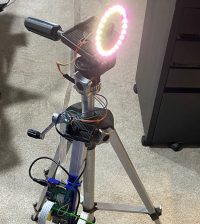- How to Adjust X and Y Axis Scale in Arduino Serial Plotter (No Extra Software Needed)Posted 2 months ago
- Elettronici Entusiasti: Inspiring Makers at Maker Faire Rome 2024Posted 2 months ago
- makeITcircular 2024 content launched – Part of Maker Faire Rome 2024Posted 5 months ago
- Application For Maker Faire Rome 2024: Deadline June 20thPosted 6 months ago
- Building a 3D Digital Clock with ArduinoPosted 11 months ago
- Creating a controller for Minecraft with realistic body movements using ArduinoPosted 12 months ago
- Snowflake with ArduinoPosted 12 months ago
- Holographic Christmas TreePosted 12 months ago
- Segstick: Build Your Own Self-Balancing Vehicle in Just 2 Days with ArduinoPosted 1 year ago
- ZSWatch: An Open-Source Smartwatch Project Based on the Zephyr Operating SystemPosted 1 year ago
TAP-HAT: Low-Cost Hardware Debugger for Raspberry Pi

Tap-Hat is a multi-purpose JTAG debugger board for those developing software to run on Raspberry Pi: RTOSs, Linux and bare-metal code in particular.
The TAP-HAT has been designed to provide a straightforward fool-proof connection of external JTAG debuggers. Including popular hardware debuggers such as the Lauterbach TRACE32, Ronetix PEEDI, SEGGER J-Link and others.
TAP-HAT features include:
- Low-cost multi-purpose JTAG debugger for Raspberry Pi boards
- Optional add-on modules enable USB-connected debugging of Pi and/or UART debug output
- Straightforward attachment of external JTAG debuggers to the Pi
- Use with OpenOCD server running native on Pi to create a low-cost networked hardware debugger
- Stackable reverse-HAT design allows concurrent connection of standard peripheral HATs
- Redboot bootloader supports configuration of Pi JTAG pin map and high-speed serial debugging
- Supports JTAG initiated system reset of Pi
- Can be used for bare-metal applications, eCosPro RTOS applications, and other OSes such as Linux
Physically, it mates with the Raspberry Pi IO header, but extends away from the Pi (unlike a typical HAT which site over the Pi) to allow probing access to Pi components. Its stacking header allows further HATs to be connected over the Pi in the normal orientation.
Further information can be found on TAP-HAT product’s page.















